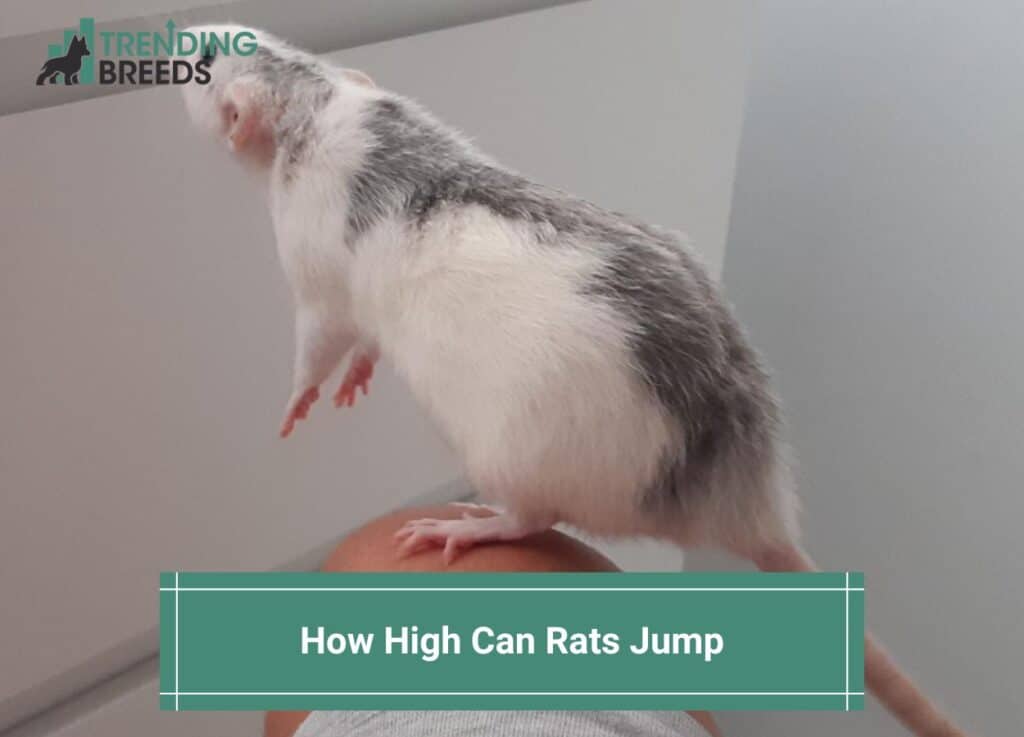
Rats are renowned for their extraordinary athleticism and agility, including the ability to jump at impressive heights. The brown rat, in particular, has been the subject of several research studies to measure its jumping capabilities. So, how high can a rat jump?
Brown rats can leap as high as 77 centimeters or almost 2.5 feet off the ground. Moreover, these rodents can jump over four feet on horizontal or downward slopes.
The brown rat owes its remarkable jumping abilities to its powerful hind legs, built for speed and agility, enabling the animal to make quick turns and accelerate rapidly.
Additionally, rats are incredibly versatile and can adjust their jumping techniques to suit different situations.
Rats are among the most adaptable animals in the world, capable of thriving in various environments. Read on to learn more about them!
Before you scroll further down this guide, check out these other rat-related articles: Do Rats Have Bones? and Do Rats Play Dead?.
Table of Contents
How Do Rats Jump?

Examining their anatomy more closely is essential to comprehend rats’ jumping abilities. For example, rats possess powerful hind legs to push off the ground during a jump.
Their tails also play a critical role in maintaining balance and steering while in mid-air. In addition, the agility and flexibility of rats enable them to jump and turn rapidly, allowing them to evade obstacles or predators.
Rats utilize a variety of techniques to launch themselves into the air. One such process involves propelling themselves off the ground using their hind legs while utilizing their tail to maintain balance.
Another technique consists in using their tail to generate upward force, thereby allowing them to achieve greater heights than they would have been capable of otherwise.
Factors That Can Affect a Rat’s Jump

Age and Health
Factors like age and health may impact a rat’s jumping ability. For example, aging can cause muscles and bones to weaken, making it harder for rats to jump as high or far as before.
Additionally, malnourished or sick rats may have reduced muscle strength or coordination, hindering their jumping performance.
External Factors

External factors also play a crucial role in a rat’s jumping ability. The type of surface they jump on can significantly affect their performance.
Rats can jump higher and farther on softer surfaces like soil or grass than on more complex surfaces such as concrete or metal.
Moreover, surface texture and incline can also impact jumping ability. Rats jump more efficiently on rough or uneven surfaces that provide a better grip.
Genetic Factors
Finally, genetic factors can also influence the jumping ability of rats. Different rat species may have evolved distinct jumping capabilities based on their natural habitats.
For instance, tree-dwelling rats may possess longer tails and more muscular hind legs, enabling them to jump and climb more effectively.
Why Would A Rat Jump?

Stay Safe From Predators
Rat jumping provides numerous benefits, including the ability to evade predators rapidly and effectively. However, rats are vulnerable to predators, including snakes, birds of prey, and larger mammals.
Still, their high and far jumps enable them to quickly move beyond their predators’ reach and seek refuge in trees, bushes, or other hiding spots.
Helps Tackle Rough Terrain

In addition, jumping helps rats traverse uneven or rugged terrain with greater ease. Rats inhabit diverse environments, from forests and grasslands to urban areas, and must move efficiently across various surfaces.
Jumping allows rats to move quickly over obstacles and rough terrains, such as fallen logs, rocks, and other debris.
Conserve Energy
Rats have also developed specialized jumping techniques to conserve energy and move more efficiently.
For instance, rats may use a “springing” technique to launch themselves forward by pushing off the ground with their hind legs and using the resulting momentum.
Minimizing Injury

Alternatively, rats may use a “parachuting” method to control their descent and land softly, minimizing the risk of injury.
Overall, rat jumping provides a clear evolutionary advantage, allowing rats to escape predators, navigate challenging terrain, and move quickly and efficiently in their natural habitats.
By examining how rats have evolved to jump, we can gain valuable insights into their behavior and biology, enabling us to develop more effective pest control and conservation methods.
Rat Jumps: True and False

Over the years, numerous myths and misconceptions about the jumping ability of rats have spread around.
Unfortunately, these falsehoods can create confusion about the true capabilities of rats and hinder the development of effective pest control methods.
This article will examine some of these myths and misconceptions in detail.
Rats Can Jump Farther Than They Can Run
The popular belief that rats can jump further than they can run is, in fact, accurate.
Jumping enables rats to move across challenging terrain and obstacles quickly and effectively, allowing them to easily cover more ground than running alone.
Rats Can Fly

Despite the impressive height from which rats can jump, they cannot fly. Although rats can glide short distances using their tails, they cannot maintain flight like birds or insects.
Rats Can Jump Over our Heads
Contrary to popular belief, no scientific evidence supports the claim that rats can jump over a human head.
Although rats possess impressive agility and can jump beyond their body height, it is improbable for them to leap over a person’s head.
In reality, rats steer clear of humans and generally attempt to conceal themselves or flee when encountering people.
Rats Can Reach 6 Feet When Jumping

One of the most widespread misconceptions about rats is their jumping capacity, but no scientific basis exists for this claim.
Studies have revealed that rats can leap up to 3 feet in height from a stationary stance. Although some outliers may be capable of jumping slightly higher, it is improbable for any rat to jump 6 feet or more.
By dispelling these myths and misconceptions, we can enhance our comprehension of rats’ genuine abilities and devise more efficient pest control measures.
Despite their agility and adaptability, pest control methods can impact rats.
By utilizing evidence-based strategies and comprehending rats’ behavior and mobility, we can strive to supervise better and manage rat populations in urban and rural settings.
FAQs About a Rat Jumps

What can rats not climb?
Rats are excellent climbers who can scale various surfaces, including walls, trees, and pipes. However, there are certain surfaces that rats may find difficult to climb, such as entirely smooth or made of metal.
These surfaces need more traction for rats to grip onto and can make climbing difficult or impossible. Additionally, incredibly steep or angled surfaces may challenge rats as they struggle to maintain balance and grip.
Can rats jump out of a 5-gallon bucket?
Rats can jump up to three feet vertically from a stationary position, so they can jump out of a 5-gallon bucket if they can reach the bucket’s rim.
However, if the bucket has smooth sides or there is nothing for the rat to climb on inside the bucket, it may be more difficult for them to escape.
Therefore, to prevent rats from entering a 5-gallon bucket, it is essential to ensure the bucket is somewhere where rats cannot climb onto it and to cover the top of the bucket with a secure lid or wire mesh.
How high can rats jump in feet?
Rats can jump vertically up to three feet from a stationary position. However, some rats may be able to jump slightly higher than this, depending on their strength and agility.
It is important to note that rats can also jump horizontally and can leap over four feet on horizontal or downward slopes.
How high can rats and mice jump?
Rats can jump vertically up to three feet from a stationary position. However, some rats may be able to jump slightly higher than this, depending on their strength and agility.
Rats can also jump horizontally and leap over four feet on horizontal or downward slopes.
On the other hand, mice cannot jump as high as rats. They can typically jump about 12 inches vertically from a stationary position.
However, like rats, mice can also jump horizontally and can cover a distance of up to 18 inches in a single jump.
How high can a rat jump?
Rats can jump vertically up to three feet from a stationary position. However, some rats may be able to jump slightly higher than this, depending on their strength and agility.
Rats can also jump horizontally and leap over four feet on horizontal or downward slopes.
So How High Can Rats Jump?

Rats are remarkable athletes capable of impressive jumps. Brown rats can jump as high as 77 centimeters or almost 2.5 feet off the ground and over four feet on horizontal or downward slopes.
They owe their jumping abilities to their powerful hind legs built for speed and agility and their ability to adjust their techniques to suit different situations.
Internal factors such as age and health, external factors such as surface type and texture, and genetic factors also play a role in a rat’s jumping abilities.
Finally, while rats can jump farther than they can run, they cannot fly, jump over human heads, or jump six feet or more.
If you find this guide, “How High Can Rats Jump,” informative and helpful, you can check out these other rat-related articles from our team:
You can learn more about rats by watching “Interesting Facts About Rats To Keep As Pet” down below:




